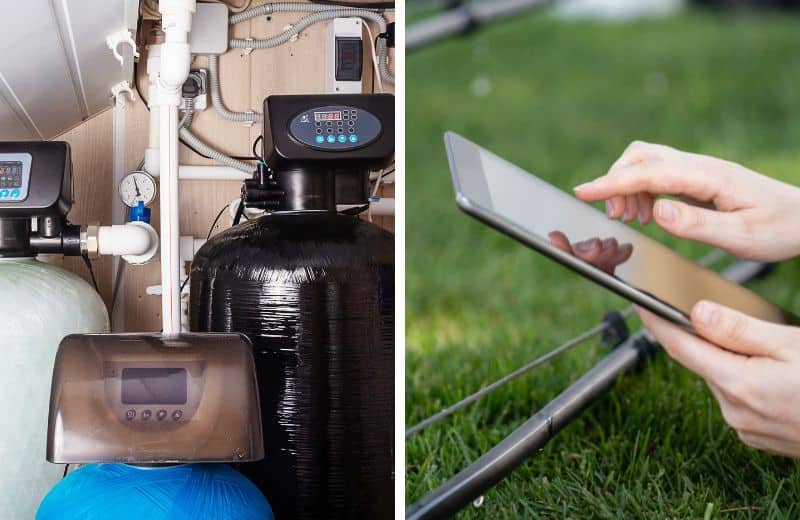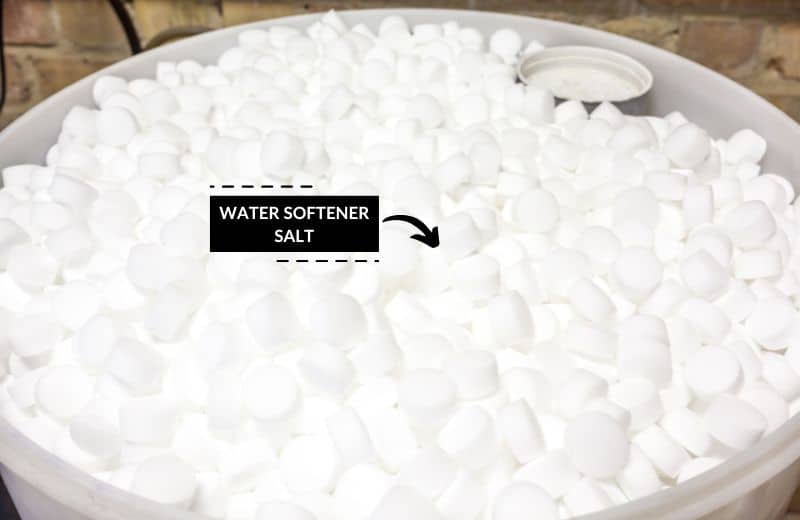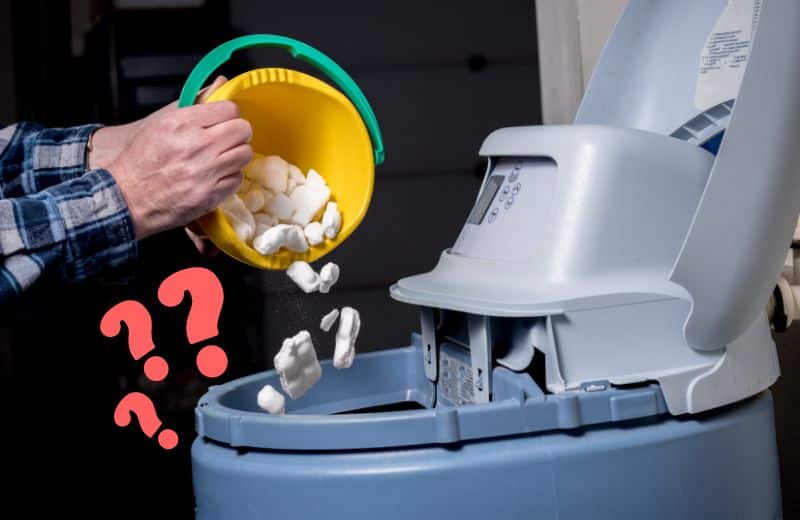If you’ve invested in a salt-based water softener for your home, it goes without saying that salt is one of the most important factors for proper functioning.
Without water softener salt, the ion exchange process is unable to take place. There’s no sodium to replace the calcium and magnesium hardness minerals, and so these minerals remain in your water.
You know you need to add salt to your softener – but how often should you do it?
How much salt should you add?
And how can you remind yourself to make salt top-ups?
I’ve covered it all in this short guide.
Table of Contents
📅 How Often to Add Salt to My Water Softener?
There are a number of factors that might affect how often you need to add salt to your water softener.
If you have high water hardness levels, for instance, a higher concentration of calcium and magnesium minerals will need to be removed, and resultantly, your system will use more salt per gallon of water.
Therefore, you’ll need to add salt to your water softener more frequently.
Your household water usage is another contributing factor.
If you use an above-average volume of water in your home, more water will need to be softened per day, and the system will need to regenerate more frequently.
To keep up with your water usage, you may need to top up your softener with salt more regularly than the average water softener user.
There are certain habits that can help you to add the right amount of salt to your softening system at the right time. These include:
Use a Smart System & App
Many modern water softeners come with smart control heads, which calculate your water usage and determine how often you need to add more water softener salt to the system.
You can usually connect your smart system to an app via Bluetooth. The app will send notifications to your home screen when you need to check the salt or add more salt to the brine tank.
Smart water softener systems tend to provide the easiest solution for salt top-ups. You don’t have to remember yourself, as you’ll be reminded automatically.

Check the Brine Tank
Even if your water softening system reminds you to top up the salt each month, you might still want to check the brine tank from time to time for peace of mind.
Diagnosing your brine situation is pretty obvious: if the tank is still full of salt, it doesn’t need topping up. But if your salt levels have fallen below the fill line, you could choose to pour in some more.
There’s no need to constantly add more salt every time the system completes a regeneration cycle.
The general rule of thumb is that you should top up your salt when the brine tank is less than half-full.
Your salt level should always be a couple of inches above the water level.
Look for Salt Bridges
Salt bridges are produced when pockets of air form inside your brine tank. If you misjudge how much salt you need and end up adding way too much, this can result in a salt bridge.
You should always make sure the salt level is at least 4 to 6 inches below the top of the tank, which should reduce the likelihood of bridging.
Salt bridges look like hard, packed blocks of salt.
A salt bridge will usually form over the top of your water level in the brine tank. It’s important to clear salt bridges as soon as you notice them, as they can prevent your system from performing a regeneration cycle, which can affect the entire water softening process.
Set a Reminder
If your water softener doesn’t have a smart control valve, or you’d rather not rely on a Bluetooth app, you could set a calendar reminder on your phone.
Simply schedule one day per month – I’d recommend once every 3 weeks – to check your salt level and pour in more if necessary.
Setting a reminder on your phone takes seconds to do, and it’s a low-stress option that doesn’t require actively remembering to top up your salt yourself. If you have a busy lifestyle, setting a phone reminder should be the best option for you.
Consider the System’s Age
The older your water softener gets, the less efficient it becomes in treating hard water. That may mean that you have to top up the system with a larger amount of salt for it to do the same job as it did with less salt in the past.
If your system is older than 10-15 years, you should consider the benefits of purchasing a replacement model. The newer water softeners are generally built better than the older ones and should last longer, too.
⚖️ How Much Salt Do You Put in a Water Softener?
At a very minimum, your brine tank should be one-quarter full. This is the minimum amount of salt needed for the water softener to create brine for regeneration.
When you’re adding water softener salt, make sure you stop once the salt is about 6 inches below the top of the brine tank.
A full-size whole home water softener for a family of four will use around one 40lbs bag of salt every month. This equates to approximately a 10lbs bag of salt every week.
Of course, it’s worth checking your brine tank from time to time to check that your system isn’t using salt at a faster rate than this. If your water hardness level is higher than 7 to 10 gpg, you may need more frequent salt top-ups.
To learn more about the salt recommendations for your own water softener, refer to your user manual. This should give you information that’s specific to your system, which is far more helpful than anything you’ll read on the internet. You may also be able to adjust your unit to use a lesser amount of salt on a monthly basis.

Can You Overfill a Water Softener With Salt?
You might think that filling your brine tank to the brim with salt is the best way forward, considering it’ll space out your refills and give you less work on the whole.
But overfilling the brine tank can actually do more harm than good.
Putting too much salt in your brine tank is the biggest cause of salt bridging (when the salt clumps together and doesn’t properly mix with water to form a brine solution).
This can be confusing to you, because with a salt bridge at the top of your tank, your tank will appear full. In reality, the salt may have been completely used underneath the bridge, and you wouldn’t be able to see it.
Overfilling your brine tank with too much salt is an easy mistake to make if you don’t know when you’re supposed to stop.
Make a note that you should keep your tank around half-full to two-thirds full, preferably no higher.
It’s better to top up your tank with less sodium, more frequently, rather than fill the salt level too high.
✔️ How to Add Salt to a Water Softener?
Water softeners can vary in design, but usually, you’ll need to add salt to a dedicated brine tank.
Simply locate the brine tank and fill it with salt. The brine tank will be the most accessible tank on your water softener, unlike the resin tank, which is usually sealed.
You don’t need to remove the brine tank when adding salt. Simply open the lid, pick up your bag of salt, and carefully pour enough salt to pass the half-full mark. Your aim is to add enough salt to your softener to get rid of any standing water above the salt.
Don’t worry about mixing the salt – the tank will empty from the bottom during your water softener use.
If you spot a salt bridge, however, carefully pry the loose salt away from the inside of the tank and fish out any large blocks before you continue. You can use hot water to dissolve the clumps for convenience.
Once you’ve finished adding salt, close the lid of the tank. The water softener is now ready to go again – and your job is done! It’s that simple.

🧂 What Type Of Salt Should I Use?
You can’t just use normal table salt in your water softener. The crystals that make up table salt are much smaller than those that make up water softener sodium. This means that salt mushing is far more likely to be a problem for you.
The most popular types of salt for water softeners are evaporated salt and solar salt. Both kinds of salt are suitable for turning hard water into soft water, regardless of your water usage or your type of resin.
In terms of quality, however, there is a difference between the two.
Evaporated salt pellets have the highest purity, which makes them the highest quality option for your water softener.
The purity of your softener salt is an indication of the percentage of sodium vs other materials, like dirt, which can build up in the bottom of your tank. Evaporated salt is also less likely to cause mushing or bridging when your unit is producing soft water.
Solar salt crystals or pellets are still an effective means of treating hard water, but they’re not quite as soluble. Most brands of this type of salt offer at least 99.6% pure sodium, which is pretty decent.
Related: Should I used water softener pellets or crystals in my system?
There’s a final salt for softeners option you might see on the market, and that’s rock salt. However, I wouldn’t recommend this for your water softener, despite the fact that it tends to be the cheapest option. That’s because it contains more dirt, as well as calcium sulfate, which doesn’t dissolve as effectively.
Water softeners can also be topped up with potassium chloride. This option can be a little more expensive, as potassium chloride isn’t as widely available. But its salt-free softening benefits make it an option worth considering if you’re on a low-sodium diet or you just want to minimize your salt intake.
We’ve published a full guide on the best salt for water softeners if you’re looking for more information.
